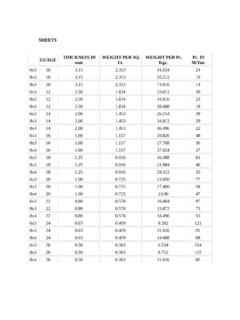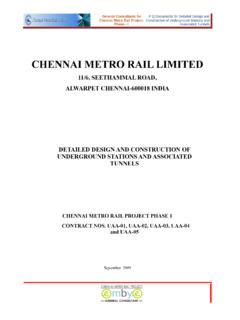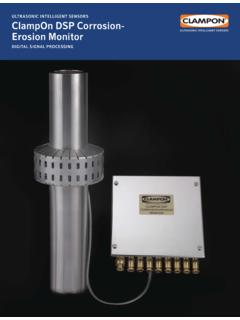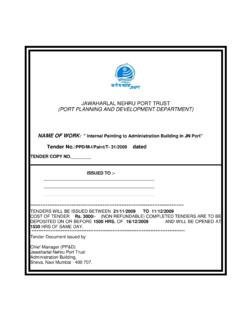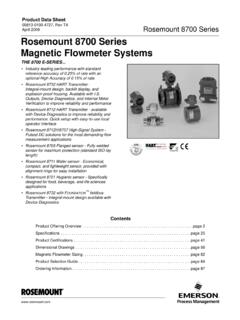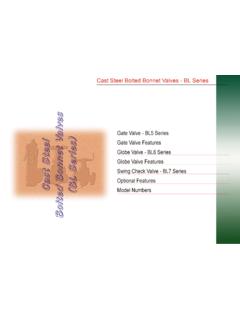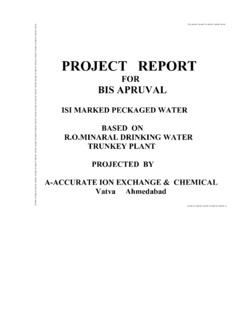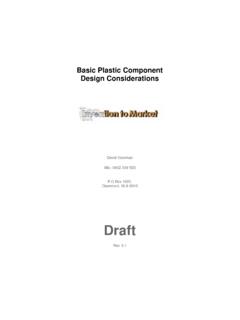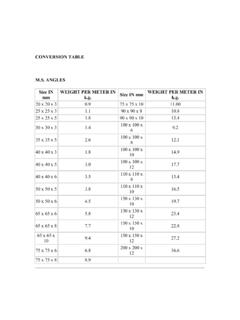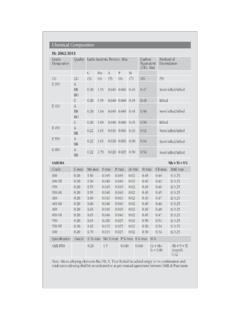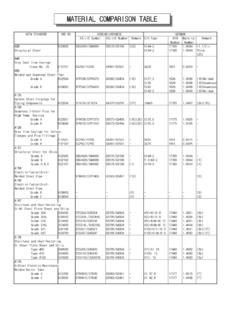Transcription of COR-TEN,CORTEN A,CORTEN STEEL,A242,A558 GR …
1 COR-TEN,CORTEN A,CORTEN STEEL,A242,A558 GR A,S355 JOW,DIFFERENT TYPE AND GRADES OF CORTEN A STEEL / Weather resistant steelPhysical PropertiesWeather resistant steelStandardTensile Strength MPaYield Strength MPaElongation in 2 inches (min.) %CORTENAUS steel470-63035520 IRSM 41-97 Indian Railways480 min340 min21 ASTM A 588 ASTM485 MIN345 min21 Chemical PropertiesWeather resistant A A242-04 High-Strength Low-alloy Structural SteelChemicals Composition%Tensile Maxt< <t< <t< Thikness (t)mmYield Point Ksi(N/mm2)Tensile Strength Ksi(N/mm2) (345) Min70(480) MinTest Piece In (mm)46(315) Min67(460) MinGL=8(200)GL=2(50)18 2142(290) min63(435) MinRemarks:1 For plates wider than24 in(600mm), the Elongatior requirment is reduce Two Percentage For normal thickness 5/16in(8mm), the deduction from the specified percentage of elongation in 8 in(200mm). Shall be made for decereses of the nominal thickness below 5/16 in.
2 (8mm). See elongation requirement adjustment under the tension tests section of specification A6 for deduction for Corten Steel Strip & Coil according tp Jis 3125-87(SPA-H & SPA-C)JAPAN STANDARDType SymbolCSiMnPSCuCrNiYield N/mm2 to to to to max343 min481 minSPA-C34 min451 minStandardsEuropeMaterial FlachstahlFK1) 36 WA 3WR 50 A--Allwesta 510 36 WA 4-A 242 Type 1-Allwesta 510 36 WB 3WR 50 BA 588 SMA 50 AWAllwesta 52-3E 36 WB 4WR 50 C-SMA 50 CPAllwesta 510 510 F 40B1)FK = Tensile strength classChemical composition in percent by weight1)[%] (Heat analysis) ,120,75max. 1,000,06 - 0,150,0350,0093)0,25 - 0,550,30 - 1,250,65S355J2WP0,120,75max. 1,000,06 - 0,150,030 4)0,25 - 0,550,30 - 1,250,65S355 JOW0,160,500,50 - 1,50max. 0,0350,0350,0092) 3)0,25 - 0,550,40 - 0,800,65S355J2W0,160,500,50 - 1,50max. 0,0300,030 4)0,25 - 0,550,40 - 0,800,65S355K2W0,160,500,50 - 1,50max. 0,0300,030 4)0,25 - 0,550,40 - 0,800,651) The steel may contain a maximum of 0,65 % Ni, 0,30 % Mo and 0,15 % ) Exceeding the specified maximum value is permitted if the phosphorous content remains below the maximum value by 0,005 % for each 0,001 % of nitrogen; however, the nitrogen content must not exceed 0,012 % in the heat ) The maximum nitrogen content shall not apply if the steel grades contain at least 0,020 % Altotal or sufficient quantities of other nitrogen-fixing elements.
3 4) The steel grades contain at least one of the following elements: Altotal : 0,020 %, Nb: 0,015 - 0,060 %, V: 0,02 - 0,12 %, Ti: 0,02 - 0,10 %. If a combination of these elements is present, at least one of them is contained with the specified minimum content. Mechanical properties1)GradePosition of sampleMin. yield strengthTensile strengthMin. total elongation [%]MPaMPaL0= 80 mmL0= 5,65 S0e2) 16e2)> 16e2)< 3e2) 3e2) 22 < e2) 2,52,5 < e2) 3e2) 3S355J0 WPl/t355-510 - 680470 - 63016/1417/1518/1622/20S355J2 WPl/t355-510 - 680470 - 63016/1417/1518/1622/20S355J0Wl/t3553455 10 - 680470 - 63016/1417/1518/1622/20S355J2Wl/t3553)34 5510 - 680470 - 63016/1417/1518/1622/20S355K2Wl/t3553)34 5510 - 680470 - 63016/1417/1518/1622/201)The tensile test values given in the table apply to longitudinal samples; in case of strip and sheet steel of widths of 600 mm, transverse samples should be ) Nominal thickness e [mm]3) S355J0WP and S355J2WP: e 12 impact energy in condition of delivery (minimum values obtained using Charpy-V samples)GradeNotch impact energy1)PositionJ0CS355J0WP270S355J2WP27 -20S355J0W270S355J2W27-20S355K2W40-20 Average values of 3 samples; one individual value may fall short of the required minimum value by not2)More than 30 %.
4 The sample width shall equal the product thickness if the latter is between 5 - 10 mm,3)The tests being performed using samples which are similar to Charpy-V samples. The valuesspecified 4)In the table above are to be reduced proportionally to the sample , CORTEN, CORTEN A, CORTEN STEEL, A242, A558 GR A, S355 JOW,ScopeCORTEN A applies to plates up to in thickness, CORTEN B applies to plates up to 50mm in means that due to their chemical compositions CORTEN A and CORTEN B steels, when utilised unprotected, exhibits increased resistance to atmospheric corrosion compared to unalloyed steels. This is because it forms a protective layer on its surface under the influence of the corrosion retarding effect of the protective layer is produced by the nature of its structure components and the particular distribution and concentration of alloying elements in it. The layer protecting the surface develops and regenerates continuously when subjected to the influence of the , duration of development and protective effect of the covering layer on weathering steels depend largely upon the corrosive character of the atmosphere.
5 Its influence varies and depends mainly upon general weather condition ( continental) macroclimate ( industrial, urban, maritime or countryside climate) and the orientation of the structure components ( exposed to or shaded from the weather, vertical or horizontal position). The amount of aggressive agents in the air has to be taken into account . In general the covering layer offers protection against atmospheric corrosion in industrial, urban and countryside utilising this steel in unprotected condition it is up to the designer to take into account the expected loss of thickness due to corrosion and as far as necessary, compensate for it by increasing the thickness of the cases of particular air pollution by aggressive agents conventional surface protection is recommended. Coating is absolutely necessary in cases of contact with water for long periods, when permanently exposed to moisture, or if it is to be used in the vicinity of the sea. The susceptibility of paint coats to undercreepage by rust is less in the case of weathering steel than in the case of comparable non-weathering corten steel is used for various types of welded, bolted and riveted constructions steel frame structures, bridges, tanks and containers, exhaust systems, vehicles and equipment guidles for the use of corten steel in the unprotected condition are described in EN 10025-5 and DASt rule entire application technology is of fundamental importance for the performance of the products made from this steel.
6 It must be taken into account that not only general climate conditions but also specific unfavourable local climate conditions in the broadcast sense as well as details of a construction may affect the corrosion behaviour of unprotected weathering steel. The dependency on these facts makes it understandable that no warranty can be given. It is recommended to control the corrosion progress of protected parts out of weathering steel exposed to the influence of weather in reasonable time intervals. A minimum thickness of 5mm is recommended when exposed to the weather in the unprotected use the benefits of the higher atmospheric corrosion resistance of CORTEN in comparison to unalloyed steel it is necessary that design and execution of structures as well as the performance of maintenance works allow an impeded formation and regeneration of the protective rust layer. The methods must meet the latest requirements of technical progress and must be suited for the proposed application.
7 Due consideration must be given to relevant construction selection of the material is up to the Composition(heat analysis, %)GradeCSiMnPSCrCuVNiCOR-TEN order to obtain fine grain structure a sufficient amount of nitrogen absorbing elements is added ( Al).Mechanical Properties, in the state of delivery conditionAt room temperature for plates 3mm in thickness (transverse test specimans, according to EN 10002). Requirements to hot rolled plates 3mm in thickness according to EN yield point (ReH Mpa *)Tensile strengthRm MPaMinimum elongation A (Lo= So) %COR-TEN A355470-63020*) 1 Mpa = 1N/mm2In case of cold rolled material the yield point is min. 310 Mpa and the tensile strength min. 445 MPa. Furthermore cold rolled sheets 3mm in thickness made of steel grade COR-TEN A-F for increased demand to the cold formability is available. Mechanical properties: Yield point min. 275 Mpa; Tensile strength min. 410 Mpa; elongation min. 25%. Tolerances on dimensions and shape according to EN Properties, in the state of delivery conditionAt room temperature for plates 3mm in thickness (transverse test specimans, according to EN 10002).
8 Requirements to hot rolled plates 3mm in thickness according to EN thickness mmMinimum yield point (ReH Mpa *)Tensile strengthRm MPaMinimum elongation A (Lo= So) %COR-TEN B 16355470-63020> 16 50345*) 1 Mpa = 1N/mm2 The notched-bar impact energy is determined on ISO-V longitudinal test specimans at a temperature of - 20 C as an average of three tests. For product thicknesses 10mm the average value is at least 27 J. For thicknesses between 10mm and 6mm, the minimum impact value is reduced proportionally to the speciman width (product thickness).No impact test is performed on products below 6mm in of Tests1 tensile test1 test specimen per 40 t from eachheat*)1 notched bar impact test(3 specimens)1 set specimens per 40 t from each heat *)(at test temperature -20 C)*) as referenced in EN 10025-5 General Processing InformationThe information given below can only deal with some important conditions for hot forming are in accordance with those stated in EN 10025-5.
9 For cold forming the statements according to table 6 of EN 10025-5 are valid. If the mechanical properties have undergone changes due to cold forming, the properties indicated in the table can be substantially restores by stress relieving - at least 30 minutes at 530 C - 580 C. For higher degrees of cold forming subsequent normalising is CuttingCORTEN is suitable for flame cutting provided proper operating methods are used. At temperatures below 5 C a sufficiently wide zone on either side of the intended cut should be preheated. If flame cut edges are to undergo cold forming, the hardening effect should be prevented by preheating - as in the case of S355J2 or the hardened zones must be worked off by appropriate can be welded both manually and mechanically, provided the general rules of welding practices are observed. A prerequisite for obtaining identical mechanical properties in the weld and in the base material is the application of suitable welding consumables and the choice of appropraite welding conditions.
10 To consider are EN 10025-5 - Technical delivery conditions for structural steels with improved atmospheric corrosion resistanceRecommendations for welding are also given in EN 1011 part 1 and part 2 - Welding, Recommendations for welding of metallic basic electrodes, inert-gas welding wire, and wire/power combinations equivalent to the tensile strength of S355 are used as welding consumablesFor unprotected use care must be taken that the welded joint is also weather resistant. This is possible by using welding consumables matching the base due to design or building specification stress relieving is required, it should be performed in the range temperature from about 530 C to 580 and RivetingJoining elements such as bolts, rivets and their accessories (nuts and washers) must be so selected that the formation of local electro-chemical cells are avoided. The joining elements should preferably consist of weathering these joints capillary action can lead to permanent moisture resulting in increased corrosion.
